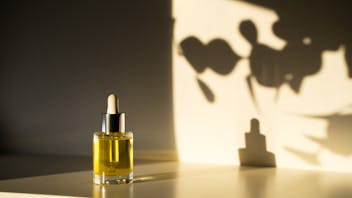Product Overview
Our organic Tonka Bean Butter is destined to become a favorite body care ingredient. Comprised of 94-96% fatty acids, the delightful almond/hay-like aroma of this aromatic material makes it perfect for use in small amounts in dry, mature and sensitive skin products, as well as for hair and cosmetic applications.[1] It has a very rich, almond-like, powdery-sweet aroma of new mown hay with a warm herbal and soft tobacco-like undertone that is very tenacious.
Oleic acid (an Omega 9 fatty acid) is the predominant fatty acid present in Tonka Bean Butter (nearly 50%)[2]; though not an essential fatty acid, Oleic acid helps to maintain moisture in the skin and helps improve the appearance of mature skin.[3],[4] Other fatty acids found in Tonka Bean Butter are linoleic acid, behenic acid, lignoceric acid, palmitic acid, and several others.[5]
Historically, the beans (which are technically seeds[6]) of the Tonka tree are removed from the ripe fruits and further processed to produce the aromatic substance coumarin[7], a material that has a very rich, sweet, hay-like aroma.[8] According to Steffen Arctander, the fatty oils found in Tonka beans contain coumarin and other aromatic substances.[9]
In natural perfumery, Tonka Bean is used as a non-floral sweetener for introducing warm notes in chypres, fougères, new mown hay bases, Amber bases, Lavender bouquets, etc. It can add a natural gourmand effect in white flower accords, such as tuberose, and also harmonizes well with vanilla, leather and tobacco notes. Prior to the availability of synthetic coumarin, tinctures of Tonka beans were long used as a source of natural coumarin, the compound responsible for the beans’ sweet Vanilla-like aroma.[10] Groom states “About 10% of all modern quality perfumes contain Tonka, examples being Je Reviens, Raffinée, and Red, and it appears among the main ingredients of some 13% of quality fragrances for men.”[11]
Also worth noting, and contrary to coumarin’s reputation, Tisserand cites that “humans are not at risk from externally applied coumarin, and no toxic effects have been reported for any coumarin-containing essential oil or absolute. … We see no need for a coumarin dermal limit, either for toxicity or skin sensitization.”[12]
1 Industry communication.
2 Ibid.
3 Ibid.
4 Parker, Susan M. Power of the Seed – Your Guide to Oils for Health & Beauty, 2014, p. 80.
5 Industry communication.
6 Tisserand, Robert and Rodney Young. Essential Oil Safety 2nd ed., 2014, p. 456
7 Arctander, Steffen. Perfume and Flavor Materials of Natural Origin, 1960, p. 625.
8 Ibid, p. 624.
9 Ibid, p. 626.
10 Wells, F.V. and Marcel Billot. Perfumery Technology – Art: Science: Industry, 2nd ed., 1975/1981, p. 64.
11 Groom, Nigel. The New Perfume Handbook, 2nd ed., 1997, p. 330.
12 Tisserand, Robert and Rodney Young. Essential Oil Safety, 2nd ed., 2014, p. 543-544.



